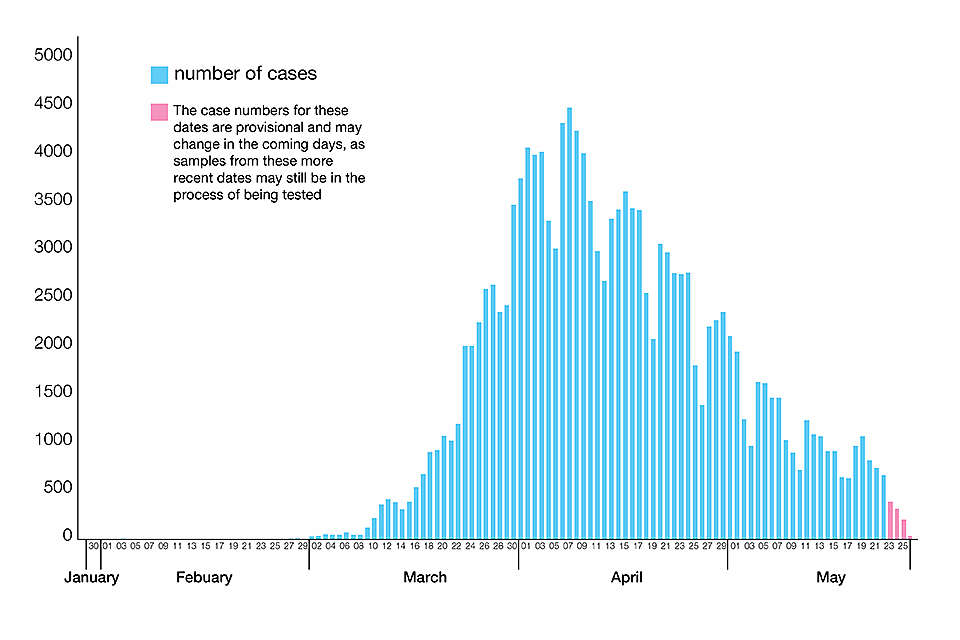HPR volume 14 issue 10 (26, 27 and 29 May)
Updated 23 December 2020
COVID-19 guidance: eighth update
On 28 May 2020, the UK government formally launched the NHS Test and Trace service whereby those testing positive for coronavirus in England will be contacted and requested to share information about their recent interactions.
The service is underpinned by increased availability and speed of testing, the establishment of a cadre of contact tracers, ranging from call centre staff to experienced public health specialists and coordinated work by local authorities, Public Health England (PHE) Health Protection Teams and the Joint Biosecurity Centre to identify and quickly contain localised outbreaks.
Four new or updated sets of public health guidance were published (described below) aimed at individuals, households, employers and employees, including health and social care workers, who have specific responsibilities under the NHS Test and Trace scheme.
1. Summary of the NHS Test and Trace service
New Department of Health and Social Care (DHSC) and PHE guidance explains how:
- those who are contacted by the service because they have tested positive for coronavirus should respond to the service’s request for details of their recent interactions and contacts
- those who are contacted by the service, because they have been identified as a contact of someone who has tested positive, should follow precautionary advice they receive from the service, including getting tested where appropriate
2. Updated stay at home guidance
Updated PHE guidance for households with possible coronavirus infection, now includes information on the Test and Trace service.
3. New guidance on responding to putative out-of-household contact with COVID-19 cases
New PHE guidance for contacts of people with possible or confirmed coronavirus infection who do not live with the person, covering situations where an individual has been informed by the service that they are a contact of a confirmed case who is not within the same household.
4. Workplace guidance for employers and employees
New DHSC guidance covering workplace precautions and employer and employee responsibilities: NHS test and trace: workplace guidance. This includes an explanation of employers’ obligations relating to workplace risk assessment that takes account of COVID-19.
National Weekly Surveillance Report (NWSR)
The number of institutional COVID-19 outbreaks in England continued to decline, according to data presented in the latest NWSR published on 28 May (including data for week 21 of 2020).
There were 264 new acute respiratory institutional outbreaks (2 or more people experiencing a similar illness, linked to a particular setting) reported in England in week 21 (compared with 343 in the previous week). Of these, 215 were in care homes (compared with 295 in the previous week), 78 tested positive for SARS-CoV-2 (compared to 112 in the previous week); 13 outbreaks were in hospitals (the same number as in the previous week), 12 tested positive (compared with 7 in the previous week); 3 were in schools (compared with 4 the previous week); 4 in prisons (compared with 1 the previous week); and 29 were in other institutions (compared with 30 the previous week).
The latest NWSR, presenting data up to 9:30am on Wednesday, 27 May (week 21), records that 903,678 people had been tested for COVID-19 in England, of which 150,903 had been confirmed positive. Overall case numbers and the proportion testing positive continued to decrease in week 21. The highest number of cases continued to be seen in older age groups, with more cases being seen in females; this probably reflects testing patterns as positivity rates are similar in both genders. Infection rates continue to be highest in the North of England.
The infographic that accompanies the NWSR provides more detailed trend information, across a wider range of parameters, than the COVID-19: tracker (updated daily).
The epidemic curve for England for the week-ending Wednesday 27 May (week 21, 2020) is shown below.

Chart showing laboratory-confirmed COVID-19 cases (England) as at 27 May 2020.
Sero-prevalence epidemiology
The latest NWSR includes seroprevalence data for the first time, with an explanation of its significance.
Control of COVID-19 requires the ability to detect asymptomatic and mild infections that would not present to healthcare and would be undetected by disease surveillance systems. PHE is collecting serological samples as part of Pillar 4 of the government’s testing strategy; this involves testing blood samples from a range of sources for the purposes of population surveillance, rather than for the diagnostic testing of individuals.
The results of blood sample analyses carried out between mid-March and mid-April showed that the highest prevalence of antibodies against the virus was among young adults; also that the prevalence of antibodies among young adults in London was higher than elsewhere.
Infection reports in this issue of HPR
Laboratory confirmed cases of measles, rubella and mumps (England): January to March 2020.
Group A streptococcal infections: third report on seasonal activity in England, 2019 to 2020.
Routine reports of gastrointestinal infections in humans (England and Wales): March and April 2020.
Vaccine coverage report
Pertussis vaccination programme for pregnant women update: vaccine coverage (England), January to March 2020.
